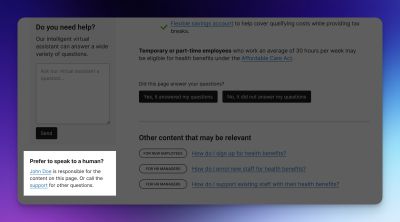In today’s web development landscape, the concept of a monolithic application has become increasingly rare…

Overcoming The Challenges Of Content Creation For Informational Websites — TechRuum
Web apps and e-commerce sites may get all the love these days, but the majority of the web is still informational, and most websites are still content-led. Whether it’s a marketing website trying to convince you to buy a product or an informational site seeking to educate and answer your questions, the web is still dominated by words. But unfortunately, these sites face two substantial challenges:
- According to the Nielsen Norman Group, users only read 20 to 28% of a webpage.
- Most people who write content for the web lack the necessary skills, which leads to poor-quality content.
In an ideal world, professionals would write our website copy, but that rarely happens, especially in larger organizations. Instead, we have an eclectic mix of people from all parts of the organization posting content online, which is why content quality is often poor.
Of course, complaining about this fact fixes nothing. So, what can we do to improve the copy on our websites when we potentially have dozens of inexperienced people posting the copy online?
Unsurprisingly, there’s no single magic answer that will fix the quality of our site content. However, there are four techniques we can use that together can get us where we want to be. When implemented correctly, these techniques can have a transformational impact.
Technique #1: Provide Content Creators Training
In my experience, most of the training that content creators receive focuses on how to use the content management system, not how to write good web copy. Even when they do receive training on how to write online, this is often in the form of live training.
Live training has its place, but it comes with its drawbacks. It is hard to arrange and needs to be repeated every time there is a new member of staff. However, the biggest problem with live training is that unless the person goes out of that training session and starts using what they learned immediately and on an ongoing basis, they quickly forget what they have learned and fall back into old patterns of writing.
What content creators really need is training material they can easily reference when they sit down to create content for the website. The material should be broken down into modules that are directly related to things they might want to do, like the following:
- How to optimize a page for search engines.
- How to ensure your page is accessible.
- How to structure your content.
- How to write clear and engaging titles.
- How to make content more engaging.
And so on.
Each module should be small, self-contained, and take only a few minutes to digest. Ideally, it should also be supported by video walkthroughs and include specific actions people can take.
There should also be checklists that ensure they have thought of all the things that need doing when writing, all as quickly accessible as possible.
Technique #2: Make Content Creators Accountable
To address this issue, we can assign every page on a website to a specific individual and potentially even add their contact details to the page in case users have questions. Doing this motivates content creators to ensure the page answers as many user questions as possible and is up-to-date.

You may meet resistance to this idea because people change roles, and so responsibilities change. However, that is why pages should have a specific owner. Too often, pages do not get handed over when people move on, and these orphan pages are abandoned, leading to content ROT (redundant, out of date or trivial content).
Ensuring content remains relevant and up-to-date is essential, which leads me to my third technique.
More after jump! Continue reading below ↓
Technique #3: Establish Governance Around Website Content
The only way content will remain up-to-date is if it is reviewed regularly. And to achieve that, we need some governance that motivates content creators to do exactly that with the pages for which they are responsible.
You can create this motivation by establishing a policy stating that if certain conditions are not met, the content will be archived.
What these conditions are is entirely up to you. You could require a page to meet a certain threshold of page views or engagement (encouraging content creators to ensure page titles are relevant and clear.) You could even flag pages that perform poorly in search engine rankings.
However, as an absolute minimum, you should require pages to be reviewed regularly — how regularly will depend on your content and situation.
For instance, I work on many public sector and higher education websites where change is slow. In such cases, an annual review of pages is usually sufficient, except for certain time-sensitive pages.
If the condition is not met (such as the page not being reviewed by a required date), the page could be removed from navigation and search, effectively orphaning it. Whatever you decide, it should also have a banner added to the page saying that the content may not be up-to-date and to contact the page owner for the latest information. This will motivate the content creator to update the page to avoid a lot of emails!

Another condition I often use is poor user feedback on a page, which brings me to my final technique for ensuring quality content.
Technique #4: Provide Content Creators with Good Feedback
One way to gather user feedback for content creators is through surveys. Surveys can be added to the bottom of a page or integrated into the site experience, asking users how they found the content and if there is anything missing that they would like to see.
Another way to gather feedback is through social media listening. Monitoring social media channels can help you understand how users are engaging with your content and what they are saying about it. This can be valuable in identifying areas of your site that may need improvement or in identifying content that resonates with your audience.
In addition, it’s important to regularly review your site’s analytics to see which pages are performing well and which are not. Special attention should be given to dwell time, traffic levels, and search engine rankings.
By analyzing this data, you can better understand which pages may need improvement or which topics are of most interest to your audience.

Whatever the case, all of this feedback needs to be made available to content creators because if the page rates poorly, it will encourage content creators to act.
You can also take this technique even further by celebrating the most successful content creators or the most improved pages by giving out awards and prizes (much like employee of the month).
Bringing It All Together
To bring these techniques together, we can create a content creator’s dashboard that shows each content creator all the pages they are responsible for. This dashboard will display how well pages are performing and highlight pages that are doing well or poorly.

At the top of the dashboard, we can flag pages that need the content creator’s particular attention — pages that are in danger of being archived because they need reviewing or have been rated poorly.
Finally, we can integrate training directly into the dashboard in the form of quick tips (like the Hemingway App example) and more detailed advice on how to address questions content creators may have at that point.

Of course, the approach I have laid out in this post is not a comprehensive solution to poor quality, but it does at least put in place a framework for improvement. One that works well for large sites that have a significant number of content creators who are not web copy specialists.
By using these four techniques together, we can ensure that the copy on our websites is of high quality and that our users find the content they are looking for.
Further Reading on SmashingMag
(vf, yk, il)
#Overcoming #Challenges #Content #Creation #Informational #Websites #Smashing #Magazine


